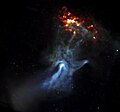Pulsar Wind Nebula

A pulsar wind nebula (also Plerion , from the ancient Greek πλήρης pléres , for "full" - introduced by Weiler and Panagia) is a characteristic looking nebula- like astronomical object that is created in the stellar wind of a pulsar .
This pulsar wind is a stream of high-energy particles created by the extreme conditions near a neutron star . Under certain conditions (creation of shock waves by braking the almost light-fast particles when entering the nebula) a pulsar wind leads to the creation of a pulsar wind nebula. The radiation of the plerion goes beyond the range of the shock wave, since the magnetic fields of the pulsar lead to the formation of synchrotron radiation and jets .
The pulsar wind nebula differs from normal supernova remnants in that it does not develop a shell structure, but rather becomes brighter towards the center; this is due to the non-thermal course of the synchrotron radiation. As a result, it can be observed in various areas of the electromagnetic spectrum , mostly from X-rays to the radio range . A typical example of a pulsar wind nebula is the Crab Nebula .
Illustrations
With the help of the Chandra space telescope , the closest pulsar wind nebulae can be mapped spatially resolved.
Web links
- Takata Jumpei: Pulsar Wind and pulsar wind nebulae . Retrieved July 6, 2009 (presentation; PDF file; 5.17 MB).
- Mallory SE Roberts: The Pulsar Wind Nebula Catalog . McGill Pulsar Group, Retrieved July 6, 2009.
Individual evidence
- ↑ Kurt W. Weiler, Nino Panagia: Are Crab-type Supernova Remnants (Plerions) Short-lived? In: Astronomy and Astrophysics . tape 70 , 1978, ISSN 0004-6361 , pp. 419-422 , bibcode : 1978A & A .... 70..419W .


